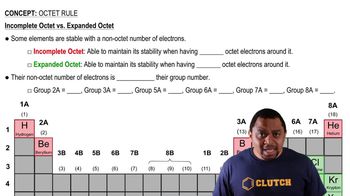Here are the essential concepts you must grasp in order to answer the question correctly.
Octet Rule
The octet rule is a chemical guideline stating that atoms tend to bond in such a way that they each have eight electrons in their valence shell, achieving a stable electron configuration similar to that of noble gases. This rule primarily applies to main group elements and helps predict the bonding behavior of atoms in molecules.
Recommended video:
Expanded Octet
An expanded octet occurs when certain elements, particularly those in the third period and beyond, can accommodate more than eight electrons in their valence shell. This is possible due to the availability of d orbitals, allowing these atoms to form stable compounds with more than four bonds, as seen in molecules like PCl5.
Recommended video:
Lewis Structures
Lewis structures are diagrams that represent the bonding between atoms in a molecule and the lone pairs of electrons that may exist. They are essential for visualizing how atoms share or transfer electrons, helping to determine whether a molecule adheres to the octet rule or exhibits an expanded octet.
Recommended video:
Lewis Dot Structures: Ions
 Verified step by step guidance
Verified step by step guidance


